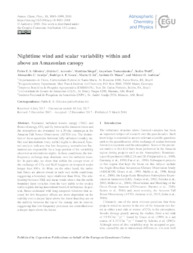Nighttime wind and scalar variability within and above an Amazonian canopy.
Nighttime wind and scalar variability within and above an Amazonian canopy.
Author(s): OLVEIRA, P. E. S.; ACEVEDO, O. C.; SÖRGEL, M.; TSOKANKUNKU, A.; WOLFF, S.; ARAUJO, A. C. de; SOUZA, R. A. F.; SÁ, M. O.; MANZI, A. O.; ANDREAE, M. O.
Summary: Nocturnal turbulent kinetic energy (TKE) and fluxes of energy, CO2 and O3 between the Amazon forest and the atmosphere are evaluated for a 20-day campaign at the Amazon Tall Tower Observatory (ATTO) site. The distinction of these quantities between fully turbulent (weakly stable) and intermittent (very stable) nights is discussed. Spectral analysis indicates that low-frequency, nonturbulent fluctuations are responsible for a large portion of the variability observed on intermittent nights. In these conditions, the low-frequency exchange may dominate over the turbulent transfer. In particular, we show that within the canopy most of the exchange of CO2 and H2O happens on temporal scales longer than 100 s. At 80 m, on the other hand, the turbulent fluxes are almost absent in such very stable conditions, suggesting a boundary layer shallower than 80 m. The relationship between TKE and mean winds shows that the stable boundary layer switches from the very stable to the weakly stable regime during intermittent bursts of turbulence. In general, fluxes estimated with long temporal windows that account for low-frequency effects are more dependent on the stability over a deeper layer above the forest than they are on the stability between the top of the canopy and its interior, suggesting that low-frequency processes are controlled over a deeper layer above the forest.
Publication year: 2018
Types of publication: Journal article
Unit: Embrapa Eastern Amazon
Keywords: Amazonia, Dióxido de Carbono, Energia cinética turbulenta, TKE, Vento
Observation
Some of Embrapa's publications are published as ePub files. To read them, use or download one of the following free software options to your computer or mobile device. Android: Google Play Books; IOS: iBooks; Windows and Linux: Calibre.
Access other publications
Access the Agricultural Research Database (BDPA) to consult Embrapa's full library collection and records.
Visit Embrapa Bookstore to purchase books and other publications sold by Embrapa.

